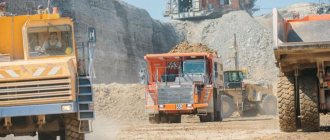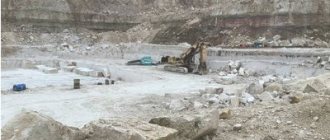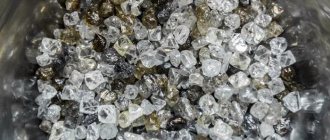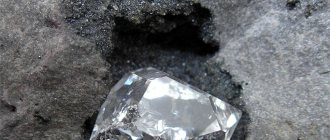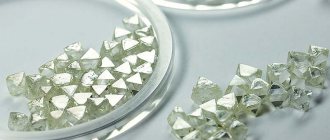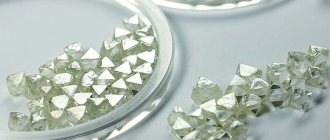Deposits in Russia and the world
Approximately 550 oil shale deposits have been discovered around the globe. The main reserves are located:
Oil shale reserve
- in America, in the states of Colorado, Wyoming, Utah;
- 21% of shale is mined in Brazil;
- Russia produces 11% of the total global volume of these minerals.
To date, all deposits cannot be developed. The reasons for the impossibility of developing oil shale are the economic unprofitability of the work, as well as the need to ensure environmental safety during the extraction of these combustible minerals.
In Europe, shale gas production is difficult to achieve due to high population density and deep formations. The most promising opportunity was to extract shale gas from Poland. This was facilitated by the discovery of large deposits and the desire of the authorities to end dependence on Russia for gas supplies. However, the projects were considered unprofitable, and the plans had to be abandoned, despite all the efforts and advertising campaign on the part of the United States.
Shale gas reserves
Deposits of such gas in Ukraine are located in the Donetsk region, in the zone of large-scale armed clashes, and in the Odessa region. The Ukrainian authorities consider the development of these fields a way to rid the country of gas imports from Russia.
In Russia, a large shale deposit was discovered in the Saratov region. 6 deposits have been found in the region, one of which, the largest, is located in the Perelyubsky district. It is planned to process on site with the installation of a reactor to simultaneously produce shale gas, shale oil and shale cement. The presence of rhenium and coke in this oil shale, which are strategic products, was revealed.
Geological exploration
Oil shale reserves in nature are quite extensive, so now exploration is mainly aimed at finding convenient development sites. For example, in Russia, up to 80% of deposits are located in the Far East, so the main attention is paid to the European part, so as not to increase the already high cost of production with expensive delivery.
Exploration is carried out using standard methods:
- Geological - geologists are looking for places where oil shale comes to the surface of the earth.
- Geophysical - special geographic maps are compiled based on the magnetic, electric, gravitational field of the Earth and the nature of the propagation of sound waves. Based on them, further exploration is carried out.
- Geochemical – chemical analysis of water, soil and air is done.
Based on the data obtained, test drilling is carried out. At the end of the drill there is a special core pipe that captures a cylindrical layer of soil for testing - a core.
The oil shale included in the sample is analyzed and the prospects for further development of the well are determined. Test drilling is an expensive, but the most informative way to determine the prospects of a deposit.
Extraction methods
Oil shale is extracted in two ways:
- career;
- underground.
Quarry or open pit method, mine mining. This is the most profitable development of shale deposits in places where formations occur close to the earth's surface. This method is environmentally friendly.
The underground method is expensive and requires the creation of shale wells, the involvement of equipment and highly qualified specialists. This method can cause significant harm to the environment, so it is not used near water bodies or cities.
Disadvantages of technology
- The deposit is rapidly aging. The average “lifetime” of wells is 1.5-2 years; during the first year of operation, the flow rate is reduced by 80%. Then production is stopped and a new well is looked for at a considerable distance from the stopped developments.
- Carbon dioxide emissions are noted. However, work is now underway to create technologies to capture the released gas. In the future, to increase the efficiency of field development, the resulting carbon dioxide is planned to be processed into electricity.
It should be noted that the technology for developing shale deposits is in its infancy. The costs of producing shale hydrocarbons exceed the cost of developing traditional oil fields. In this regard, we should not expect a repeat of the shale boom in the near future, as we saw with gas, while the discovered reserves of shale black gold should be considered as reserves of energy resources for the future.
Gas extraction process
Shale gas extraction process
Shale gas is produced from oil shale. This is a natural gas containing methane. The cost of its production is higher than that of conventional gas produced from a gas field.
To extract shale gas, it is necessary to install a large number of wells and a large area of land, because its concentration is only 0.2–3.2 billion cubic meters per 1 square kilometer.
Its extraction is carried out with significant reserves and with the desire of the authorities of some countries to reduce dependence on fuel imports.
Possible damage to the environment does not allow the development of oil shale in a significant part of the explored resources.
Shale gas is produced using hydraulic fracturing technology:
- the well is first drilled vertically, and when reaching the shale formation - horizontally;
- then, under very high pressure (500–1500 atm), water or its mixture with sand and chemicals is injected into the well;
- this leads to cracking of the rock and the release of flammable gas from it;
- To prevent the cracks from closing when the pressure decreases, liquid is supplied into the well with the addition of coarse sand.
What is slate?
Shale is a rock formed after a volcanic eruption or from sedimentary rocks under the pressure of water, the earth's crust and the influence of heat.
Another name for shale is flagstone. Their formation took place over many millions of years.
The distinctive ability of slates is to disintegrate into thin plates from mechanical impact on the surface.
The rock differs in its constituent substances and impurities, and therefore has different physical characteristics. This is also the reason for different hardness indicators on the Mohs scale from 2 to 6 points.
Some shales do not change their physical characteristics when exposed to high temperatures, while others ignite, releasing a large amount of thermal energy.
They also differ in strength. Some do not change under the influence of great mechanical force, while others are easily destroyed with little impact.
They have different colors depending on the predominant mineral impurities.
There are green, brown, yellow, black, red, and blue shales.
They are used by people in natural and processed forms.
Impact of mining on the environment
Shale gas extraction poses a danger to the environment. The fluid used in hydraulic fracturing is often supplied with large quantities of chemicals, including carcinogenic ones, which permeate the rock and lead to the contamination of large areas of land and groundwater. For this reason, shale gas production was banned in New York State.
The consequences of shale gas production for the environment are the most unfavorable:
- air and soil pollution by toxic substances contained in the solution used for fracking (hydraulic fracturing);
- soil subsidence due to rock cracking;
- destructive processes in the ground and soil;
- contamination of groundwater with chemicals.
The main environmental problem is the contamination of underground water layers not only with methane, but also with carcinogenic substances from the fracking solution.
Not only the solution itself is dangerous, but also the chemical compounds that penetrate from underground to the surface after hydraulic fracturing:
- a pestilence of birds, fish and animals occurs at the mining site;
- boiling streams containing methane gas are observed;
- toxic products released into water and air cause mass poisoning and illness of people living near drilling rigs
Ignition of drinking water can occur, this has been observed in the USA. One of the farmers decided to make a well for water to replace the poisoned one, and ran into methane, which gushed out for three days.
Experience of other countries
In China, shale oil is undoubtedly a promising energy resource. The main reserves of the field are located where the problem of water shortage is acute. Then the method of extracting oil and gas reserves with carbon dioxide was successfully applied. The process takes place at low temperatures (up to 40 degrees Celsius). This method is applicable for processing raw materials with low hydrocarbon content.
Australia currently has more than 100 oil fields that are being successfully developed and, according to scientists, the reserves will last for several more decades, or even more.
Getting oil
The reduction in oil reserves extracted by traditional methods is forcing oil workers to pay attention to oil shale, the reserves of which are an order of magnitude greater than open oil reserves. When heated without access to air, oil shale forms gas and shale oil, which is close in composition to oil and is called shale (unconventional) oil. The extraction of shale oil is feasible, from an economic point of view, only in large fields with a formation thickness of 30 meters or more and an oil content of at least 90 liters per ton of shale.
The production of shale oil is possible using reactor installations in which shale rock extracted by open pit or underground mining is processed. In these installations, shale tar (oil) is isolated using pyrolysis without access to air. This method is very expensive, the final product has a high cost.
The second way to obtain oil is by drilling horizontal wells using hydraulic fracturing technology. Such oil also has a high cost.
The disadvantage of the method of obtaining oil from the reservoir is the rapid decline in well production. After just a year of operation, there is a sharp, up to 80%, reduction in the volume of incoming oil. Both methods have problems with the disposal of large volumes of carbon dioxide, which is formed during the separation of shale tar. Its release into the atmosphere is unacceptable in order to avoid an environmental disaster.
Types of slate
Shales vary in composition and are divided into the following types:
- crystalline schists - the composition is dominated by mica and quartz, often of a gray tint, this also includes biotite schist with a predominance of black mica-biotite, they have medium hardness, low thermal conductivity and high heat resistance;
- siliceous rock - consists of dense plates with chalcedony and quartz grains. Depending on the impurities it has different colors. Solid in density, with a low level of moisture absorption, not sensitive to temperature changes;
- oil shale - the name speaks for itself, is highly flammable, has average density, looks like hardened clay, and when burned, produces a pungent odor and soot;
- clay shale is a dark-colored mineral, hard, resistant to high temperatures, insoluble in water, with inclusions of clay particles, chlorite and hydromica, emits a clayey odor when wet;
- chlorite slate - due to the chlorite content, the stone has a green color with a shiny surface, brittle, non-flammable, with a high ability to absorb sounds;
- slate slate is a soft mineral of a gray hue, easily layered into columns;
- artificial slate.
Application and processing of shale fuel
Oil shale is used as fuel and energy-chemical raw materials. From shale ore we get:
- phenols;
- adhesives;
- plasticizers;
- chemicals to control soil erosion and weeds;
- Oil shale processing waste is used to obtain construction materials (cement, etc.).
Purified shale gas has the same physical properties as traditional natural gas and is used as a fuel.
Oil produced from shale can be used directly as fuel or processed in a refinery. During the processing process, sulfur and nitrogen impurities are removed and hydrogen is added to hydrocarbons. Processed products are:
- petrol;
- diesel fuel;
- fuel oil
These products are used in the same way as conventional oil.
In Russia, 80% of extracted oil shale is simply burned at power plants. It is a cheap fuel, but its calorific value is low. Oil and gas are extracted only from 20% of deposits due to low production profitability. But the main reason is environmental protection.
Oil shale deposits are being actively developed in countries with no alternative and no natural oil and gas reserves.
Main characteristics of slate
Natural slates are composed of different minerals. The rock was formed under high pressure and exposure to different temperatures.
The advantage of the breed is:
- Resistant to moisture.
- Fire resistance.
- Immunity to natural factors.
Their formation occurred several million years ago during the period of movement of tectonic plates, volcanic eruptions and geysers. The slates are based on dark-colored stones with particles of silicon and feldspar. Some rocks contain mica.
